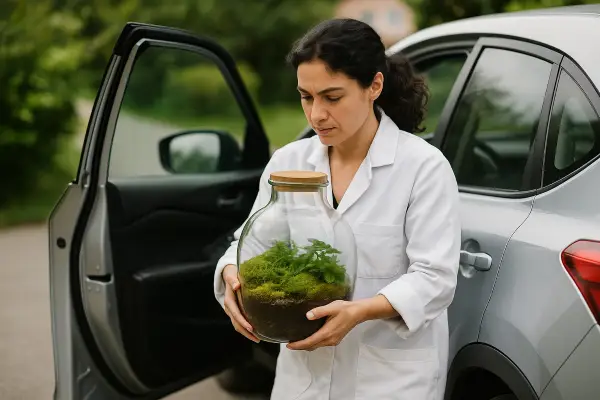Whether you’re relocating across the country or gifting a handcrafted terrarium to someone special, the question of traveling with these miniature ecosystems often arises. Many terrarium enthusiasts find themselves in this situation—torn between leaving their beloved glass gardens behind or navigating the complexities of transport. So can you travel with a terrarium?
Terrariums represent more than just decorative pieces; they’re living investments of time, care, and creativity. Understanding the logistics of travel becomes essential when these miniature worlds need to journey alongside their caretakers.
Can you travel with a terrarium?
Yes, you can travel with a terrarium within the United States, but success depends on several critical factors including size restrictions, transportation method, and destination regulations. The Transportation Security Administration (TSA) allows plants in both carry-on and checked bags on domestic flights, provided they meet airline size restrictions and can fit either in the overhead bin or under your seat.

Understanding TSA and airline regulations
According to the TSA’s official “What Can I Bring?” website, the agency allows travelers to breeze through security with live plants in both their carry-on and checked bags on domestic flights — provided they meet airline size restrictions and can fit either in the overhead bin or under your seat. This includes terrariums, which fall under the plant category.
The glass container housing your terrarium won’t pose security issues, as glass vessels are permitted through airport security. However, the final decision rests with the TSA officer on whether an item is allowed through the checkpoint, so arriving with proper preparation becomes crucial.
Size and weight considerations
Most terrariums suitable for air travel should be small to medium-sized—typically no larger than what fits comfortably under an airplane seat. Desktop terrariums and small apothecary jar ecosystems work best for air travel. Large floor terrariums or heavy glass vessels will likely exceed carry-on restrictions and pose challenges even in checked luggage.
Check with the airline to ensure that the item will fit in the overhead bin or underneath the seat of the airplane. Regional aircraft often have limited overhead space, making under-seat storage the more reliable option for smaller terrariums.
Soil and water restrictions
One advantage terrariums have over individual potted plants is their contained nature. The TSA has a thing about liquids, so if your soil was soaked that might be a problem, but damp soil will be fine. Closed terrariums naturally maintain proper moisture levels, typically avoiding the “soaked soil” concern.
For added security during transport, ensure your terrarium’s soil level sits at least an inch below the container’s opening. This prevents spillage during handling and demonstrates to security personnel that the soil is properly contained.
Preparing your terrarium for travel
Securing the Container: Place your terrarium inside a clear plastic bag with a few air holes. This contains any potential soil spillage while allowing TSA agents to view the contents clearly. Alternatively, secure plastic wrap or a lid if your container accommodates one.
Documentation: While not typically required for domestic travel, carrying a business card from a local nursery or photos showing your terrarium’s construction process can help explain its contents if questions arise.
Timing Considerations: Most plants can survive hours to days in travel conditions. Closed terrariums have an advantage here, as their self-contained water cycle continues functioning during transport.
State agricultural restrictions
There are certain states that prohibit carrying certain plants across their borders. This is to prevent the spread of insects. ( usually the Japanese Beetle) Check with Colorado and make sure no such restrictions exist. While most common terrarium plants don’t trigger these restrictions, states like California, Florida, and Hawaii maintain stricter agricultural inspection programs.
Research your destination state’s agricultural department website before traveling. Most restrictions target specific pest-prone species rather than common terrarium plants like moss, ferns, or succulents.
International travel complications
International travel is a whole different ball game when it comes to transporting your plants. Many countries — including Australia, New Zealand, and various destinations across Europe — have some pretty strict laws that apply to tourists and locals alike about bringing in foreign flora and removing native species.
No soil or earth of any kind is allowed into the United States without a permit issued in advance by USDA Plant Protection and Quarantine Permit Unit. This essentially eliminates international terrarium transport unless you’re willing to completely remove and replace the growing medium.
Alternative transportation methods
Shipping Services: Professional plant shipping services often provide better protection than airline transport. Specialized boxes with temperature control and cushioning systems protect delicate glass containers better than standard luggage handling.
Ground Transportation: Road trips allow climate control and gentle handling that air travel cannot provide. This option works well for larger terrariums or particularly delicate specimens.
Local Recreation: Sometimes the best solution involves photographing your terrarium’s design and recreating it at your destination using locally sourced materials and plants.
Security screening process
Your plant will have to go through the security point x-ray machine in most situations. Some people worry about their plants getting damaged from the x-ray machine. X-ray exposure poses minimal risk to plants, as the radiation levels used for baggage screening don’t harm living organisms.
If concerns about X-ray exposure persist, TSA agents may allow manual inspection instead, though this process takes longer and isn’t guaranteed.
Best practices for successful transport
Choose Hardy Species: Terrariums containing resilient plants like pothos, small ferns, or established moss colonies travel better than those with delicate or newly planted specimens.
Minimize Water Before Travel: Reduce watering for 2-3 days before departure to prevent overly saturated soil that might be flagged as excessive liquid.
Pack Strategically: Surround your terrarium with soft clothing in carry-on bags, or use bubble wrap in checked luggage. Avoid placing heavy items nearby that could shift during transport.
Timing Your Flight: Morning flights often experience fewer delays and gentler handling, as airport staff and baggage handlers are typically less rushed.
Conclusion
Successfully traveling with a terrarium requires careful planning and realistic expectations about size limitations and destination restrictions. While domestic travel within the United States remains relatively straightforward, international journeys present significant challenges that often make recreation preferable to transport.
Last February, I helped my colleague Elena transport her prized closed-system moss terrarium from Portland to Austin during her relocation. We chose a small apothecary jar design that fit perfectly under her airplane seat, documenting the plants inside with photos and ensuring the soil stayed properly contained. The terrarium arrived safely and continues thriving in its new home—a testament to proper preparation and understanding transportation requirements. Through experiences like these, I’ve learned that successful terrarium travel combines practical knowledge with the patience to work within existing regulations.
